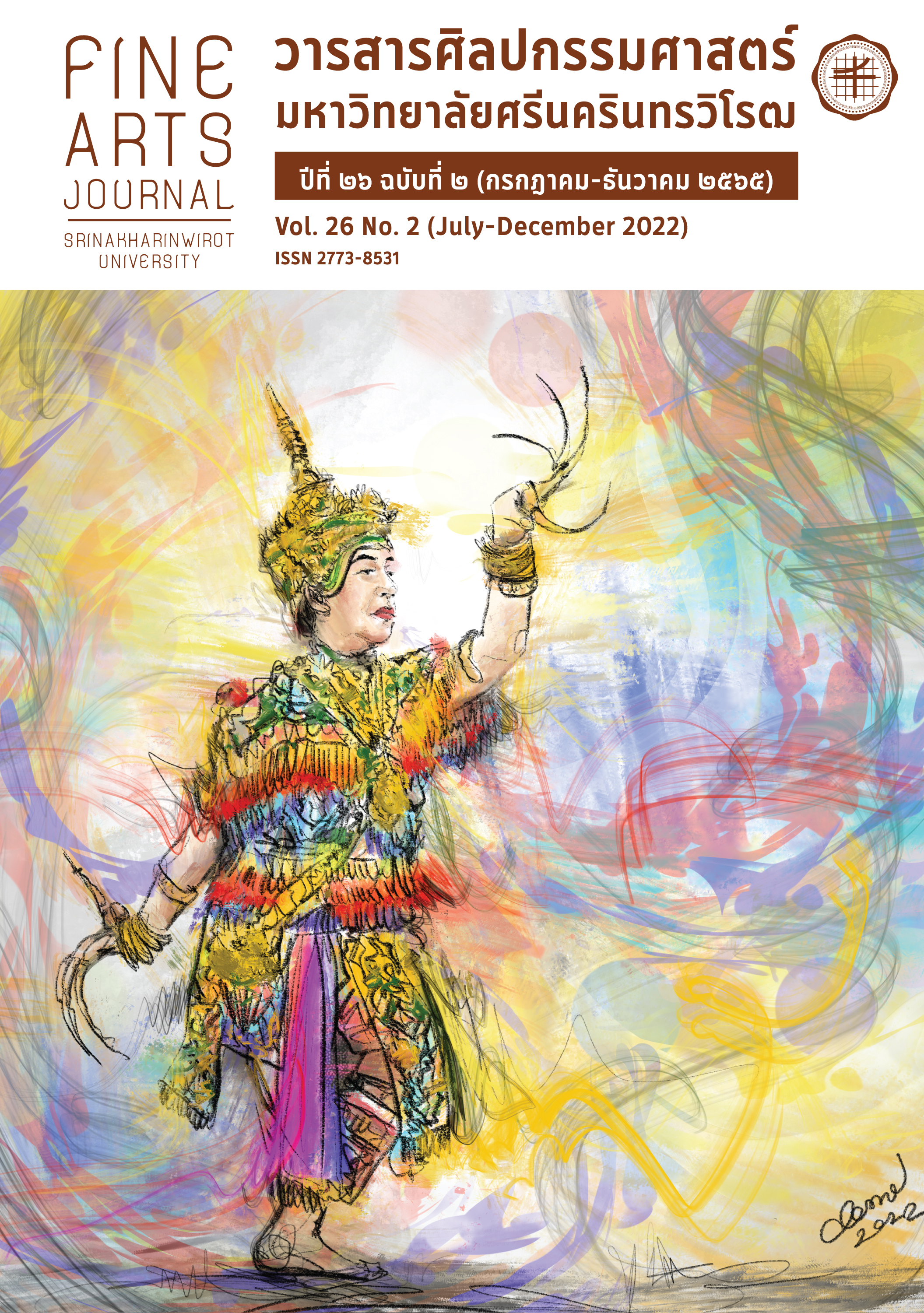GUIDELINES ON THAI DANCE TEACHING: THE UTILIZATION OF DANCE VOCABULARY WITH STUDENTS HAVING DIFFERENT BACKGROUND KNOWLEDGE
Keywords:
Guidelines for teaching Thai dance, Dance vocabulary, Different background knowledge on dancingAbstract
This article aims to present the benefits and importance of using dance vocabulary as a Thai Dance Teaching Method to enhance the knowledge of university students with different background knowledge in dancing. Dance vocabulary is not only theoretically used for communication, but provides a strong practical knowledge of dancing for a better understanding of movements of head, trunk, hands, legs, and feet.
The guidelines on using dace vocabulary for teaching Thai dance are, therefore, an important tool to help students learn effectively. In brief, it is first necessary to understand each dance vocabulary through explanation by the lecturer prior to dancing. Importantly, the selected dance vocabulary should link to each part of the human body in dance movements. This is required for a basic dance at the beginning and for an advanced dance in the future. Dance vocabulary-based learning guides a proper body movement along with a correct pattern of dancing and helps controlling one’s body while dancing. This will be helpful for any kinds of Thai dance.
Downloads
References
กรมศิลปากร. (2545). รวมงานนิพนธ์ของนายอาคม สายาคม. กรุงเทพมหานคร: รุ่งเรืองศิลป์.
โกวิทย์ ขันธศิริ. (2527). สื่อการสอนดนตรีและนาฏศิลป์ในสื่อการสอนระดับประถมศึกษา เล่มที่ 1. นนทบุรี: มหาวิทยาลัย
สุโขทัยธรรมาธิราช.
ธนิต อยู่โพธิ์. (2516). โขน. กรุงเทพมหานคร: กองการสังคีต กรมศิลปากร.
นิติญาภรณ์ ศรีไพร. (2563). การพัฒนาทักษะการปฏิบัติ โดยใช้วิธีการสอนแบบห้องเรียนกลับด้าน (Flipped Classroom)
ร่วมกับสื่อคอมพิวเตอร์ช่วยสอน (CAI) รายวิชานาฏศิลป์ ชั้นมัธยมศึกษาปีที่ 2 โรงเรียน ภูเวียงวิทยาคม. สำนักงาน
เขตพื้นที่การศึกษามัธยมศึกษาเขต 25 สำนักงานคณะกรรมการการศึกษาขั้นพื้นฐาน กระทรวงศึกษาธิการ.
นิสา เมลานนท์. (2555). การพัฒนานวัตกรรมการสอนวิชานาฏศิลป์ เรื่อง ลีลานาฏยศัพท์. วารสาร
ศิลปกรรมศาสตร์ มหาวิทยาลัยขอนแก่น, 4(1), 76-97.
ประเมษฐ์ บุณยชัย. (2544). เอกสารประกอบการสอนวิชาจารีตนาฏศิลป์ไทย. กรุงเทพมหานคร: วิทยาลัยนาฏศิลป.
ภิตินันท์ อะภัย. (2562). โขนพระราชทานกระบวนการสร้างสรรค์ผลงานทางศิลปะการแสดงโดยใช้แนวคิดศาสตร์พระราชา.
วารสารศิลปกรรมศาสตร์ มหาวิทยาลัยศรีนครินทรวิโรฒ, 23(2), 103-112.
สุชีรา อินทโชติ. (2560). การจัดทำสื่อการสอนนาฏยศัพท์เบื้องต้นในรูปแบบบทเพลงสำหรับนักเรียนระดับชั้น ประถมศึกษา
ปีที่ 2. วารสารวัฒนธรรมและศิลปะ มหาวิทยาลัยศรีนครินทรวิโรฒ, 19(1), 154-165.
สุมิตร เทพวงษ์. (2541). นาฏศิลป์ไทย นาฏศิลป์สำหรับครูประถมและมัธยม. กรุงเทพมหานคร: โอเดียนสโตร์.
ศิริเสน่ห์ หอมนาน. (2564). การพัฒนาชุดการเรียนรู้เรื่องนาฏยศัพท์และภาษาท่านาฏศิลป์ไทยสำหรับ นักเรียนชั้น
มัธยมศึกษาปีที่ 1. วารสารมนุษยสังคมปริทัศน์ (มสป.), 23(2), 76-88.
วรพรรณ สว่างจิตร. (2565). การสังเคราะห์งานวิจัยด้านการใช้ชุดกิจกรรมการเรียนรู้นาฏยศัพท์และภาษาท่า เพื่อการ
พัฒนาการเรียนการสอนวิชานาฏศิลป์. วารสารการวิจัยกาสะลองคำ, 16(1), 17-29.
วัชรพงษ์ สูงปานเขา. (2562). ภาษาอังกฤษเพื่อการสอนนาฏศิลป์ไทยพื้นฐานให้แก่ชาวต่างชาติ. กรุงเทพมหานคร: โอเอ
สพริ้นติ้งเฮาส์.
อุดม กุลเมธพนธ์. (2556). นาฏยศัพท์ฉบับครูละมุล. เชียงใหม่: สุเทพการพิมพ์.
Downloads
Published
How to Cite
Issue
Section
License

This work is licensed under a Creative Commons Attribution-NonCommercial-NoDerivatives 4.0 International License.






